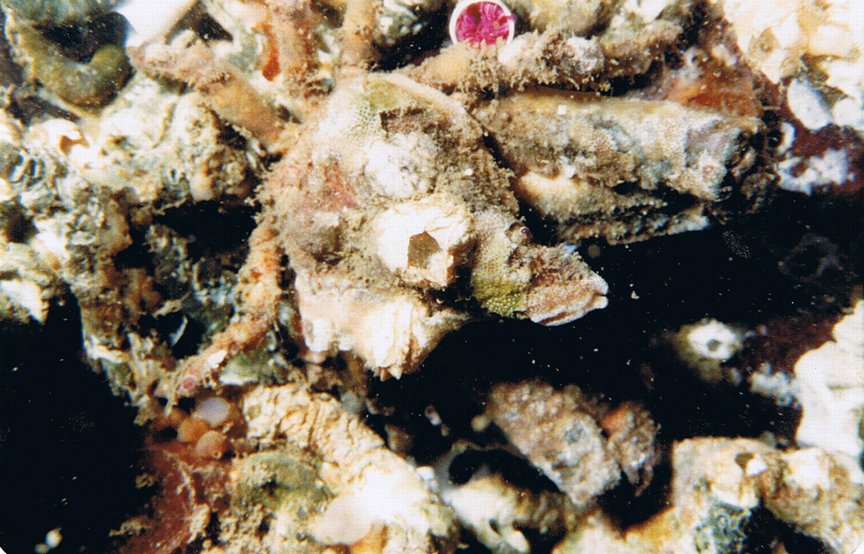| The Heart Crab – Phyllolithodes papillosusGeneral Description:
This very distinct crab is most commonly identified by the heart shaped markings on its back, hence his common name, the Heart Crab. This triangular carapace measures from 50X60mm (female) to 90X90mm (male), and is coloured a muddy greenish brown with dark red ridges. The claws, legs and carapace are covered in prickly spines, which helps to camouflage and as a defense mechanism. The Heart Crab has three pairs of walking legs coloured dark brown and a pair of chelipeds that are dark brown with turquoise bumps. Another distinction that is evident on the Heart Crab is the two blunt horns above his eyes and a large spine between them.
Domain Eukarya
Kingdom Animal
Phylum Arthropoda
Class Malacostraca
Order Decapoda
Family Lithodidae
Genus Phyllolithodes
Species papillosus
Common Name: Heart Crab
Habitat and Range:
The Heart Crab is rarely sighted in the open nor do they inhabit the intertidal zone, instead they prefer to live subtidally in a rocky habitat, hiding in crevices with moderate exposure and strong currents. They range along the Pacific coast of North America from Alaska to California inhabiting areas as deep as 183m.
Predators and Prey:
The main predator of the Heart Crab is the octopus, and the main prey of heart crabs are sponges and sea urchins, however they are observed eating other things in captivity.
Reproduction:
All mature female Heart Crabs undergo an obligate molt occuring in the spring, from March through May. At this time of molting female are held by the chelipeds of a male. After the molting is finished and the female’s exoskeleton has hardened, the couple copulate. During this a ribbon containing spermatophores is attached around the female. The fertilization occurs within hours, after this the male separates from the female. The female then incubates her eggs for almost twelve months. Eggs are layed in the late summer, August through September. Newly laid eggs are bright yellow, orange or dark red coloured which eventually dull to a muddy brown prior to hatching.
Biotic Association:
An interesting behavior observed of the Heart Crab is the form of symbiosis,commensalism, the association between two organisms when one organism benefits and the other is neither harmed nor benefited. After molting, the Heart Crab takes shelter under the tentacle canopy of the snakelock anemone, as he is not harmed by this and the crab is protected, |
 The Race Rocks taxonomy is a collaborative venture originally started with the Biology and Environmental Systems students of Lester Pearson College UWC. It now also has contributions added by Faculty, Staff, Volunteers and Observers on the remote control webcams.
The Race Rocks taxonomy is a collaborative venture originally started with the Biology and Environmental Systems students of Lester Pearson College UWC. It now also has contributions added by Faculty, Staff, Volunteers and Observers on the remote control webcams.

